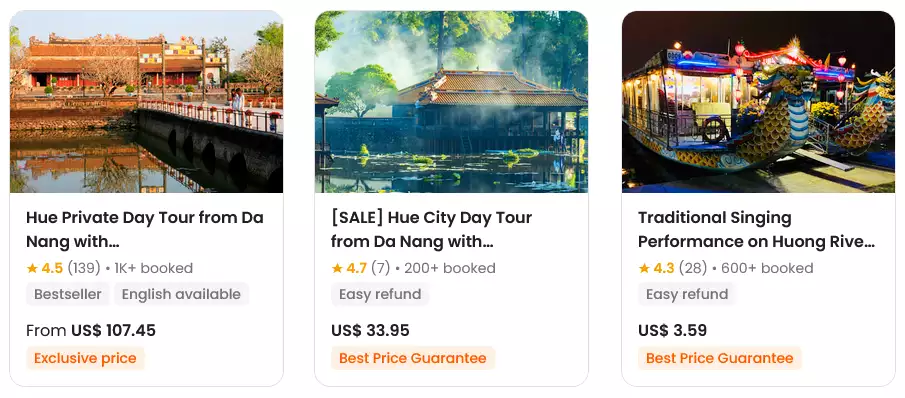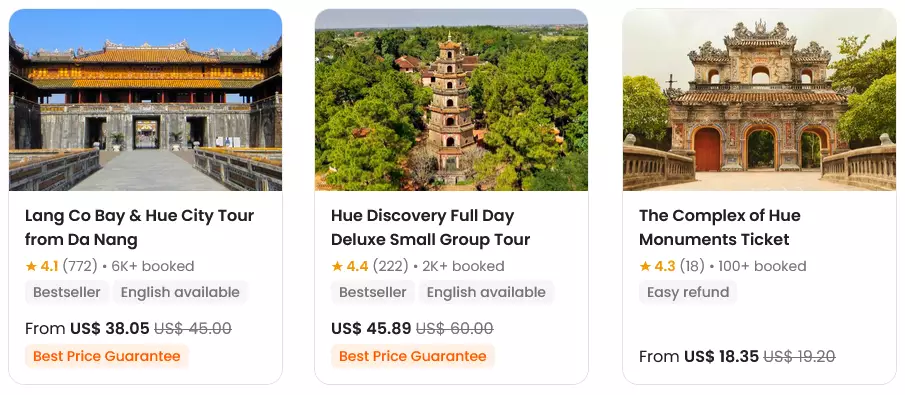
ℹ️ Information – Hue
✈️ How to get to Hue
☀️ Weather in Hue
🏡 Where to stay in Hue
🔍 Interesting Places
❓ FAQ + Travel Tips
🎫 Book a Tour in Hue
🎫 Book Ticket to Hue
Quick answer: Huế is Vietnam’s former imperial capital, full of history, serene pagodas, royal tombs, and peaceful river views. It’s a perfect destination for travelers who love culture, architecture, and a more relaxed pace — combining ancient citadels with lush countryside and thoughtful reflection.
At a glance:
- 🏯 Imperial Citadel: Explore the walled Hue Imperial City with palaces, temples, and royal chambers.
- 🛕 Thien Mu Pagoda: Iconic pagoda on the Perfume River hill, symbol of Hue.
- 📜 Royal Tombs: Visit grand tombs of Emperors like Minh Mạng and Tu Duc by the river.
- 🎨 Art & Museums: Check out the Royal Fine Arts Museum for Nguyen‑era treasures.
- ⛵ Perfume River: Take a dragon boat ride for peaceful views and cultural insight.
- 🌿 Nature Escape: Go to Bạch Mã National Park for forest, waterfalls, and mountain trails.
- ⛪ Phủ Cam Cathedral: A prominent, hilltop Catholic cathedral with striking architecture.
- 🍜 Local Cuisine: Try Hue’s specialties like bánh khoái and royal-inspired dishes.
- 🏖️ Nearby Beach: Visit Lang Cô beach just outside the city for a scenic seaside escape.
- 🕰️ Best Time to Visit: January–April is ideal — cool, relatively dry, and perfect for sightseeing.
Last updated in November 2025
Geography and Location of Hue: The Jewel of Central Vietnam:
-
- Hue is a city located in central Vietnam, situated on the eastern coast of the country. It is the capital of Thua Thien-Hue province and is located on the banks of the Perfume River, which runs through the city from north to south. Hue is approximately 660 kilometers (410 miles) south of Hanoi, the capital of Vietnam, and about 1,100 kilometers (680 miles) north of Ho Chi Minh City, the largest city in Vietnam.
- Hue is surrounded by mountains and hills, with the Truong Son Mountains to the west and the Bach Ma Mountains to the south. The city covers an area of 70.67 square kilometers (27.29 square miles), with an elevation of 5 meters (16 feet) above sea level. The climate in Hue is tropical monsoon, with high temperatures and humidity year-round, and a rainy season from September to December.
- The city is divided into two main areas: the older, historical area to the north of the river, which includes the Imperial City and the tombs of several emperors, and the newer, modern area to the south of the river, which is home to many hotels, restaurants, and tourist facilities. Hue is also close to several other popular destinations in central Vietnam, such as Da Nang, Hoi An, and the My Son Sanctuary.

What is a History and Culture of Hue:
-
- Hue has a rich and fascinating history that spans over a thousand years. The city was originally founded as a small fishing village in the 17th century, but it wasn’t until 1802 that it became the capital of the Nguyen Dynasty, which ruled Vietnam until the mid-19th century. During this period, Hue was a center of culture and religion and was renowned for its magnificent architecture, literature, and music. The Nguyen emperors built a complex of palaces and temples known as the Imperial City, which served as the political and cultural center of Vietnam.
- In 1885, the French colonialists took control of Vietnam and moved the capital to Hanoi, which marked the beginning of Hue’s decline as a political and cultural center. During the Vietnam War, Hue was heavily damaged, especially during the Tet Offensive of 1968, but many of its historic landmarks have since been restored and preserved.
- Today, Hue is known for its unique culture, which is a blend of Vietnamese, Chinese, and French influences. The city is home to many museums, art galleries, and traditional craft villages where visitors can learn about local art and culture. One of the most significant cultural sites in Hue is the Imperial City, which was the residence of the Nguyen emperors and their royal court. The complex covers an area of 520 hectares and includes numerous palaces, temples, and gardens. The Imperial City is a UNESCO World Heritage Site and is one of the most visited tourist attractions in Hue.
BOOK A TOUR / ACTIVITY in Hue ➜
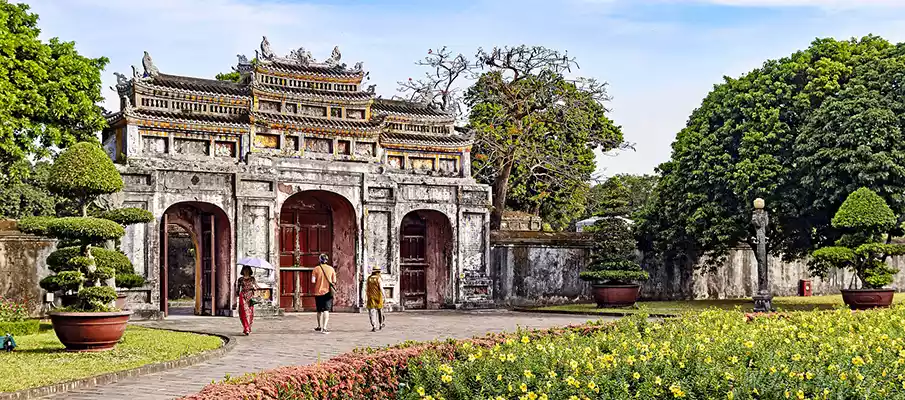
-
- Another important cultural site in Hue is the Thien Mu Pagoda, a seven-story temple that is located on a hill overlooking the Perfume River. The pagoda is considered one of the symbols of Hue and is a popular destination for visitors. Hue is also known for its traditional music, including the royal court music, which was once performed exclusively for the Nguyen emperors. The city is home to many musicians and artists who continue to preserve and promote this unique art form.
- In summary, Hue has a rich and complex history and culture that is shaped by its position as a former imperial capital and its unique blend of Vietnamese, Chinese, and French influences. The city’s many cultural sites and traditions make it a fascinating destination for visitors who want to learn about Vietnam’s past and present.
Festivals in Hue:
-
- Hue Festival: The Hue Festival is a biennial event that celebrates the culture and heritage of Hue. The festival features music, dance, theater, and other performances, as well as food and craft markets. The festival is a great way to experience the vibrant culture of Hue and see traditional arts and crafts being made.
- Royal Court Music: Royal Court Music is a unique form of music that was performed exclusively for the Nguyen emperors. The music is characterized by its slow, graceful rhythms and intricate melodies. Today, visitors can see performances of Royal Court Music at various cultural sites in Hue.
- Hue Traditional Craft Festival: The Hue Traditional Craft Festival is a biennial event that showcases the traditional crafts of Hue and the surrounding region. Visitors can see artisans demonstrating their skills in pottery, weaving, embroidery, and other crafts. The festival is a great way to learn about traditional crafts and see how they are made.
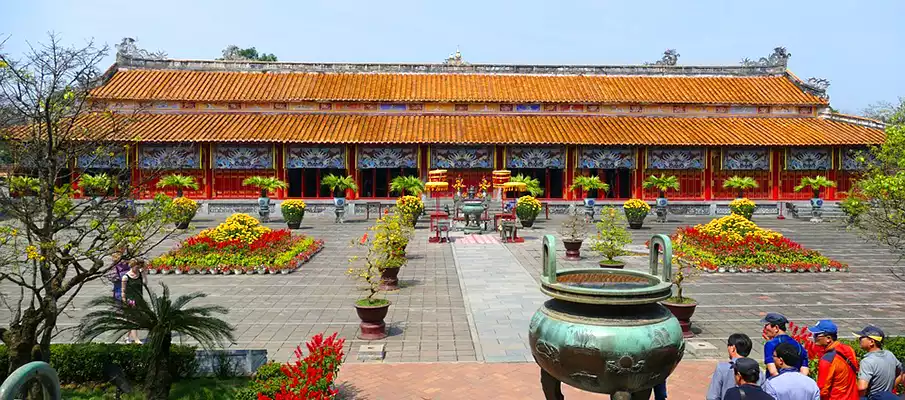
Economy in Hue:
-
- Hue has a diverse economy that is driven by a variety of industries, including tourism, agriculture, and manufacturing. Tourism is one of the most important industries in Hue, with the city attracting millions of visitors each year who come to see its historic landmarks and experience its unique culture.
-
- The tourism industry in Hue is supported by a wide range of hotels, restaurants, and other businesses that cater to visitors. In addition to the many cultural sites and landmarks in Hue, the city also has a vibrant culinary scene, with many restaurants serving traditional Hue cuisine.
-
- Agriculture is another important industry in Hue, with the surrounding countryside known for its rice paddies and vegetable farms. The fertile land and favorable climate in the region make it ideal for growing a variety of crops, including rice, corn, and vegetables.
-
- The manufacturing industry in Hue has been growing in recent years, with a focus on industries such as textiles, garments, and handicrafts. Many traditional handicrafts, such as pottery, embroidery, and weaving, are still produced in Hue and sold both locally and internationally.
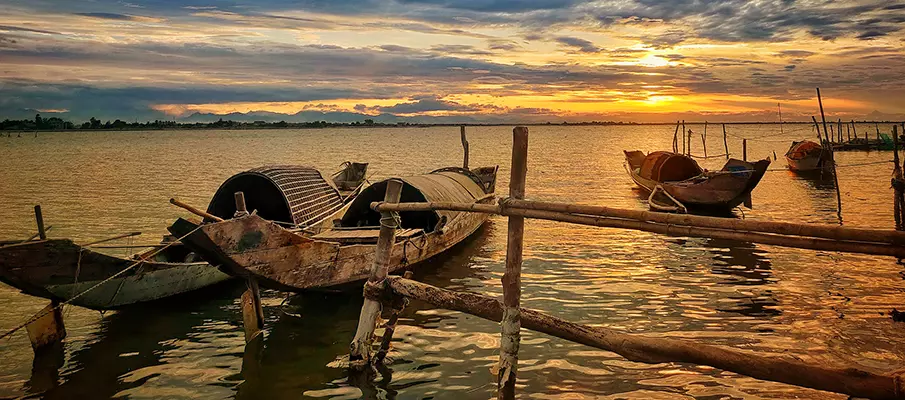
Discover the Hidden Gems of Hue:
-
- Hue is one of the most popular tourist destinations in Vietnam, known for its rich history, stunning architecture, and unique cultural traditions. The city attracts millions of visitors each year who come to explore its many cultural landmarks and experience its vibrant culture. One of the main attractions in Hue is the Imperial City, a large complex of palaces, temples, and pavilions that served as the seat of the Nguyen Dynasty emperors. Visitors can explore the many buildings and structures within the complex, including the Thien Mu Pagoda and the Tomb of Tu Duc, both of which are iconic landmarks in Hue.
- Hue is also known for its traditional cuisine, which features many dishes that are unique to the city. Some of the most famous dishes include bun bo Hue, a spicy beef noodle soup, and banh khoai, a savory pancake filled with shrimp and pork. The city has a vibrant cultural scene, with many attractive and popular festivals and events taking place throughout the year. The Hue Festival, held biennially, is a celebration of the city’s cultural heritage and features music, dance, theater, and other performances.
- In addition to its cultural attractions, Hue is also known for its natural beauty. The Perfume River, which runs through the city, is a popular destination for boat tours, while the surrounding countryside offers opportunities for hiking, cycling, and other outdoor activities. The government has been investing in tourism infrastructure and promoting the city as a top destination in Vietnam. There are many hotels, guesthouses, and other accommodation options in Hue, ranging from budget to luxury, and the city is easily accessible by air, train, or bus.
Book your Accommodation in Hue ➜
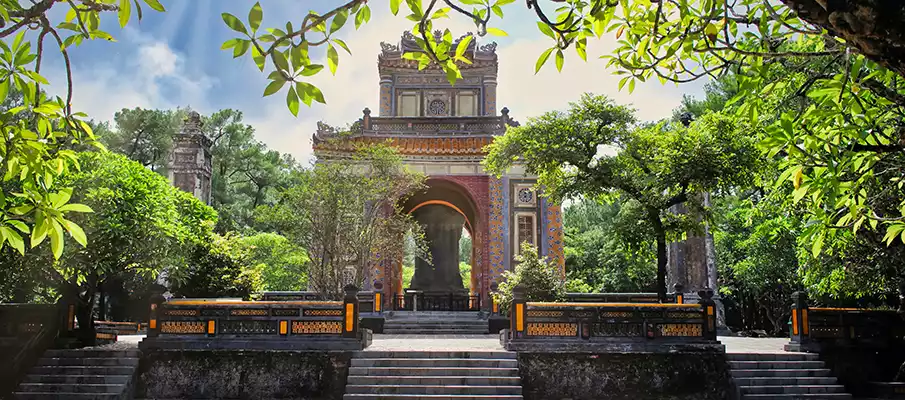
The Imperial City of Hue (Hue Citadel):
-
- The Imperial City of Hue is a vast complex of palaces, temples, and pavilions that served as the seat of the Nguyen Dynasty emperors from 1802 to 1945. The complex is located on the northern bank of the Perfume River and covers an area of over 500 hectares. The Imperial City is surrounded by a moat and high walls, and is entered through ten imposing gates, each guarded by large stone statues. Inside the complex, visitors can explore a vast array of buildings and structures, including the Forbidden Purple City, the Thai Hoa Palace, and the Hall of Supreme Harmony.
- The Forbidden Purple City was the residence of the emperor and his family, and was off-limits to all but the closest advisors and family members. The Thai Hoa Palace was the venue for important ceremonies and events, while the Hall of Supreme Harmony was used for important court meetings. The Imperial City of Hue is notable for its stunning architecture, which blends traditional Vietnamese design with French colonial influence. The complex was heavily damaged during the Vietnam War, but many of the buildings have been restored and are now open to visitors.
- Visiting the Imperial City is a must for anyone interested in Vietnamese history and culture. The complex is a UNESCO World Heritage Site and is considered one of the most important cultural landmarks in Vietnam.
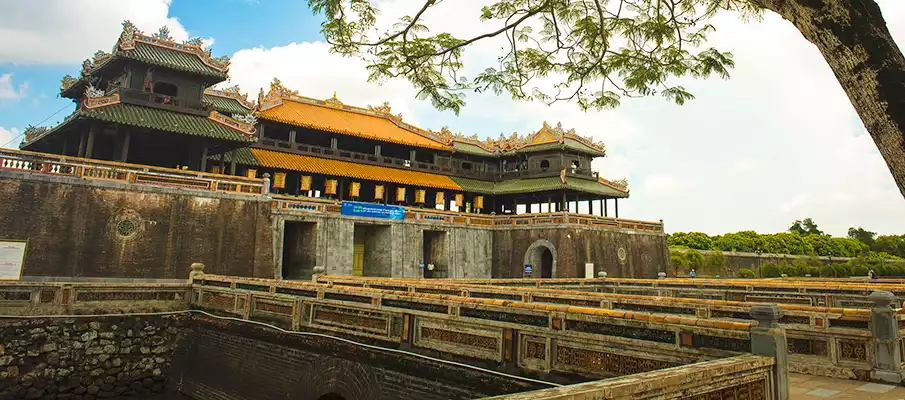
The Perfume River in Hue:
-
- The Perfume River is one of the most iconic landmarks in Hue, Vietnam. The river is approximately 80 kilometers long and runs through the heart of the city, dividing it into two parts: the north bank and the south bank. The river is a source of life for the people of Hue, providing water for irrigation and fishing.
-
- The name „Perfume River“ comes from the flowers that fall into the river from orchards upstream, which give off a sweet fragrance. The river is also associated with poetry and literature, and many famous Vietnamese poets have written about its beauty.
-
- The Perfume River is an important part of Hue’s history and culture. It was the site of many important battles during the Vietnam War, and the riverbanks are lined with historical landmarks and cultural sites. One of the most famous landmarks on the river is the Thien Mu Pagoda, which is located on the north bank of the river and is considered the unofficial symbol of Hue. The pagoda is a seven-story tower that was built in the 17th century and is still an active Buddhist monastery today.
-
- Visitors to Hue can take a boat tour along the Perfume River to explore its natural beauty and historical significance. The boat tour typically includes stops at cultural landmarks such as the Thien Mu Pagoda, as well as other historical sites along the river. The boat tour is a popular activity for tourists, offering a unique perspective on the city and its rich cultural heritage.
BOOK A TOUR / ACTIVITY in Hue ➜

Top 10 Historical Landmarks in Hue:
Hue boasts several highly significant historical landmarks and sites. The most prominent is the Imperial Citadel, but Hue and its vicinity are home to a range of other important monuments and structures. Here are the most vital among them:
-
- 1. Imperial Citadel: An impressive complex of palaces, temples, and pavilions serving as the residence of Nguyen Dynasty emperors. Located on the northern bank of the Perfume River, it’s a UNESCO World Heritage site. The Imperial Citadel encompasses the Imperial City and the Forbidden Purple City, where royal residences and offices were situated.
- 2. Royal Tombs: Several beautiful tombs of Nguyen Dynasty emperors surround Hue. These tombs are known for their unique architecture, blending traditional Vietnamese style with influences from foreign cultures. Each tomb has its own distinctive features and is surrounded by stunning landscapes.
- 3. Thien Mu Pagoda: This iconic seven-story pagoda from the 17th century is visible from afar due to its height and beautiful location on the banks of the Perfume River. The pagoda has a rich history intertwined with Buddhism, and many notable figures have come here to meditate. The pagoda offers a splendid view of the surrounding landscape.
- 4. Forbidden Purple City: This former residence of the imperial family showcases the beauty and elegance of imperial architecture. Situated within the Imperial Citadel, it was accessible only to the emperor and his immediate family. Today, you can see remains of some beautiful palaces and gardens here.
- 5. Trang Tien Bridge: This historic bridge connects the traditional part of the city with the modern center. Built during the colonial era, its elegant architecture is a fusion of Vietnamese and French elements. The bridge is a favorite spot for walks and offers a view of the Perfume River.
- 6. Dieu De Complex: This temple complex includes several old buildings adorned with beautiful sculptures and paintings. It’s a place where you can experience a peaceful atmosphere and deep spiritual ambiance.
- 7. Ngo Mon Gate: The main gate of the Imperial Citadel, also serving as an entrance pavilion. This impressive gate is richly decorated and was historically a venue for important events and ceremonies.
- 8. Thanh Toan Bridge: This picturesque bridge connects a traditional village area. Known for its covered passages and traditional markets, the bridge and its surroundings offer a glimpse into rural Vietnamese life.
- 9. Chua Ong Pagoda: This old Buddhist pagoda is famed for its rich decorations and tranquil atmosphere. It’s a place to explore the profound significance of Buddhist religion in Hue’s culture.
- 10. Khai Dinh Tomb: This intriguing tomb combines traditional Vietnamese style with European elements. It’s a tribute to Emperor Khai Dinh, featuring a rich mosaic interior and statues narrating the emperor’s life.
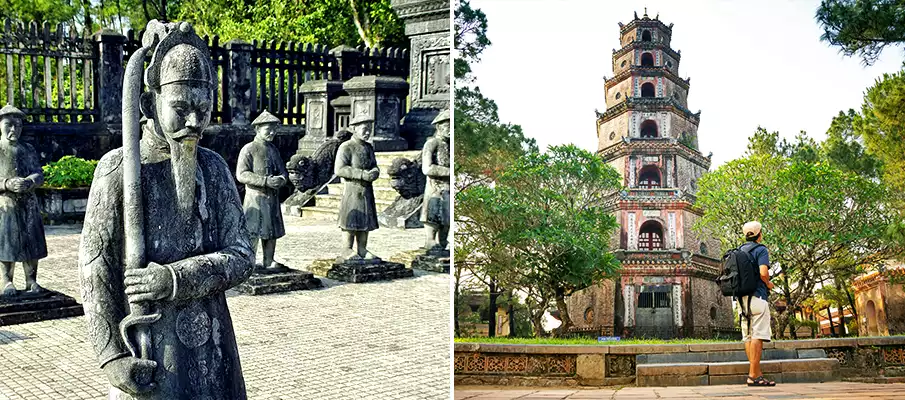
Mausoleum of Emperor Khai Dinh: A Unique Hue Landmark.
Tucked away amidst the lush landscapes of Hue, Vietnam, the Mausoleum of Emperor Khai Dinh stands as an architectural masterpiece, captivating all who visit. This imperial tomb, built to honor Emperor Khai Dinh, the 12th ruler of the Nguyen Dynasty, fuses Eastern and Western influences, making it a must-see attraction for history and architecture enthusiasts.
-
- A Unique Fusion of Styles: What sets the Khai Dinh Tomb apart from other imperial tombs is its harmonious blend of architectural styles. The monument gracefully melds traditional Vietnamese design with distinct French colonial influences. This fusion results in a captivating visual experience that reflects both the emperor’s personal tastes and the historical context of his reign.
- Intricate Interior Grandeur: Stepping inside the main tomb building, visitors are greeted by a stunning display of intricate mosaic and glass artwork. The interior’s opulence showcases a unique merger of Eastern and Western artistic elements, underscoring Emperor Khai Dinh’s fascination with foreign cultures.
- Symbolism and Scenic Views: The Khai Dinh Tomb boasts a network of courtyards, pavilions, and gardens, each thoughtfully designed to convey profound symbolism. While exploring the site, visitors can take in panoramic views of the Perfume River and the surrounding countryside, adding to the serene ambiance.
- A Glimpse into Vietnamese History: This mausoleum is a cultural and historical treasure in Vietnam, allowing guests to delve into the history of the Nguyen Dynasty. The Mausoleum of Emperor Khai Dinh offers a captivating journey through time and artistic evolution, making it an essential stop on any visit to Hue.
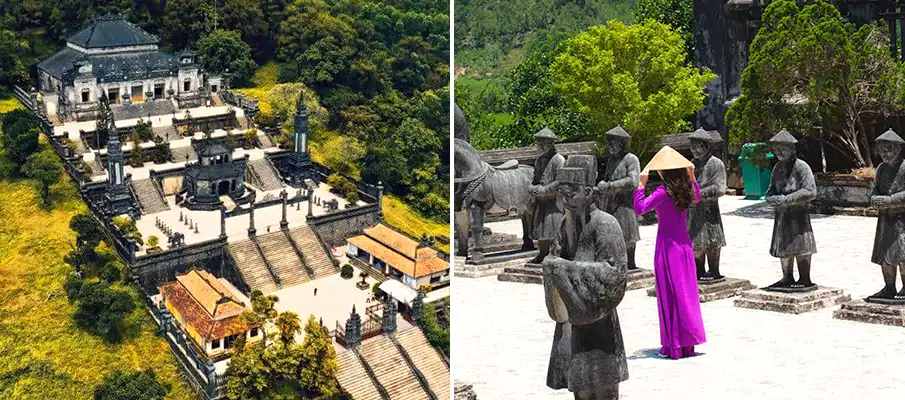
Hue Night Walking Street: Where Culture and Cuisine Unite.
In the heart of Hue, Vietnam, a magical transformation occurs as the sun sets. The city’s enchanting Hue Night Walking Street, or „Pho Dem Hue,“ comes to life, becoming a hub of culture, cuisine, and community.
-
- An Evening Spectacle: From early evening, the Hue Night Walking Street becomes a captivating spectacle of lights, colors, and lively street performers. Rows of colorful lanterns illuminate the streets, creating a dreamlike atmosphere. It’s a place where tourists and locals alike converge, looking to immerse themselves in the city’s rich cultural heritage.
-
- Culinary Delights: Hue has earned a well-deserved reputation for its culinary prowess, and this night walking street is a paradise for food enthusiasts. As you stroll along the bustling street, your senses are enticed by the aromatic symphony of street food vendors. You can savor a wide variety of traditional Vietnamese dishes, with the iconic bun bo Hue, a spicy beef noodle soup, taking center stage.
-
- Cultural Showcases: While your taste buds are on a journey of their own, your ears are treated to a symphony of traditional music and the graceful movements of dancers. Hue’s rich cultural heritage takes center stage as local musicians and artists perform on the streets, providing a melodious backdrop to your visit. Music and dance are not merely performances but expressions of local traditions and history.
-
- Shop and Stroll: The Hue Night Walking Street offers more than just culinary and cultural experiences. Along the way, you’ll come across numerous craft stalls and souvenir shops. These stalls present a unique opportunity to take home a piece of Vietnam. Here, you can browse for beautiful handicrafts and distinctive souvenirs, ensuring that your visit to the night walking street leaves a lasting impression.
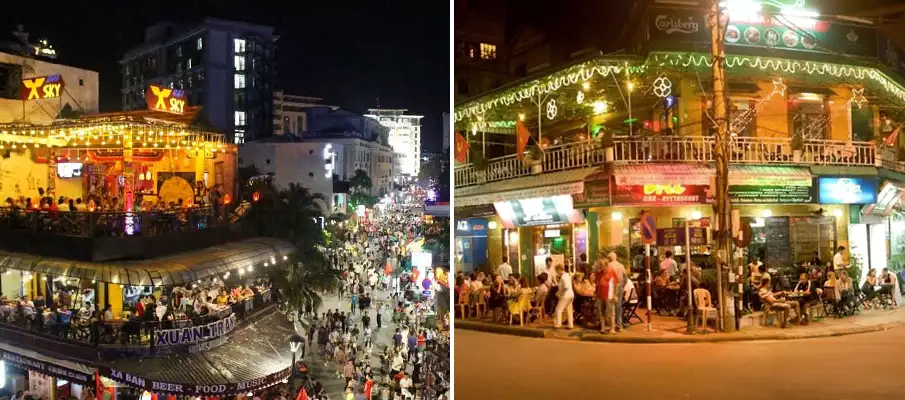
The Best and Popular Beaches For Relax Close to Hue:
Hue, in central Vietnam, is not primarily known for its beaches, but there are several beautiful coastal destinations a short drive away. Here is a list of some of the best beaches near Hue, along with detailed descriptions for each:
-
- Thuan An Beach: Thuan An Beach, situated just 14 kilometers northeast of Hue, offers a more local and laid-back experience. The long coastline provides plenty of space for beachcombing, swimming, or sunbathing. The area is dotted with seafood stalls and small restaurants where you can savor delicious seafood dishes, especially the fresh catch of the day. A scenic bridge takes you across the Tam Giang Lagoon to reach the beach, providing beautiful vistas.
- Hai Duong Beach: Bãi Biển Hải Dương, also known as Hai Duong Beach, is a lesser-known beach located in the Phu Loc District of Thua Thien-Hue Province in Vietnam. This beach is situated about 20 kilometers from the city of Hue, and it’s relatively less crowded compared to some of the more popular coastal destinations in the country. Hai Duong Beach is characterized by its long and picturesque shoreline, featuring golden sands and clear waters. While it may not be as developed as some of the famous tourist destinations, this beach provides a serene and peaceful escape for those looking to enjoy the natural beauty of the coast without the crowds.
-
- Lang Co Beach: Located approximately 65 kilometers south of Hue, Lang Co Beach is a pristine stretch of golden sand nestled between a sparkling lagoon and the South China Sea. The clear blue waters and tranquil surroundings make it a perfect spot for relaxation. You can enjoy a peaceful swim, indulge in fresh seafood at local restaurants, or simply bask in the sun while taking in the stunning views of the Hai Van Pass. Lang Co is also a great starting point for exploring the nearby Bach Ma National Park.
- Canh Duong Beach: Canh Duong Beach, also known as Alba Thanh Tan Beach, is approximately 55 kilometers north of Hue. This relatively untouched and quiet beach is a hidden gem, with soft white sand and clear, inviting waters. It’s perfect for those seeking a tranquil escape from the hustle and bustle of the city. The nearby Alba Thanh Tan Hot Springs offer a unique blend of relaxation, as you can unwind in natural hot springs and then head to the beach for a refreshing swim.
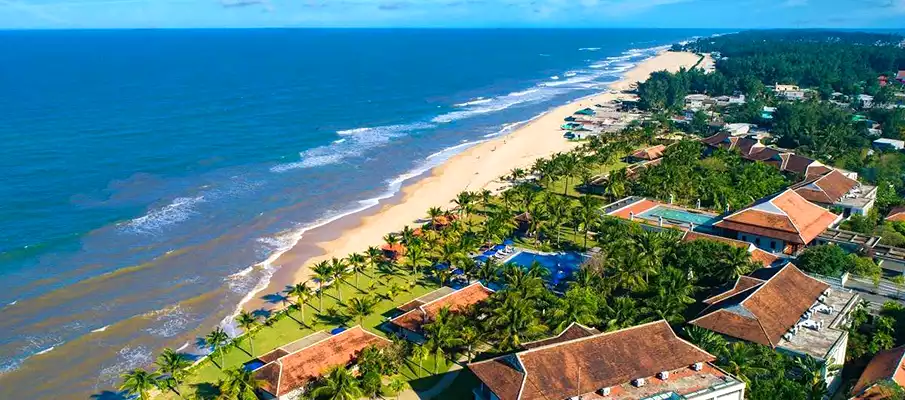
Why to visit or not to visit Hue?
Hue can be a wonderful destination for those interested in history, nature, and food. However, visitors should be prepared for hot weather, crowds, and limited tourist facilities. Despite these potential challenges, Hue’s rich cultural heritage and natural beauty make it a worthwhile destination to visit. Whether or not to visit Hue depends on your interests and preferences. Here are some reasons to visit Hue:
👉 Reasons to visit Hue:
-
- Cultural heritage: Hue is home to several UNESCO World Heritage Sites, including the Imperial Citadel and the Tombs of the Emperors, which reflect the city’s rich history and culture. Visitors can explore these sites to learn more about Vietnam’s imperial past and the country’s unique architecture and design.
- Natural beauty: Hue is surrounded by mountains, forests, and rivers, making it an ideal destination for outdoor enthusiasts. Visitors can enjoy activities such as hiking, biking, and boating to take in the area’s natural beauty.
- Food: Hue is famous for its royal cuisine, which includes dishes such as Bun Bo Hue, Banh Khoai, and Nem Lui. Visitors can sample these dishes at local restaurants and markets to experience the city’s culinary delights.
👉 Reasons not to visit Hue:
-
- Weather: The weather in Hue can be hot and humid, especially during the summer months. Visitors may need to plan their visit accordingly and stay hydrated.
- Crowds: Hue is a popular destination, and it can get crowded during peak tourist season. Visitors may need to be prepared to navigate through crowds and wait in long queues.
- Limited tourist facilities: Hue may not have as many tourist facilities compared to other popular destinations in Vietnam. Visitors may need to do some research and plan their trip accordingly.
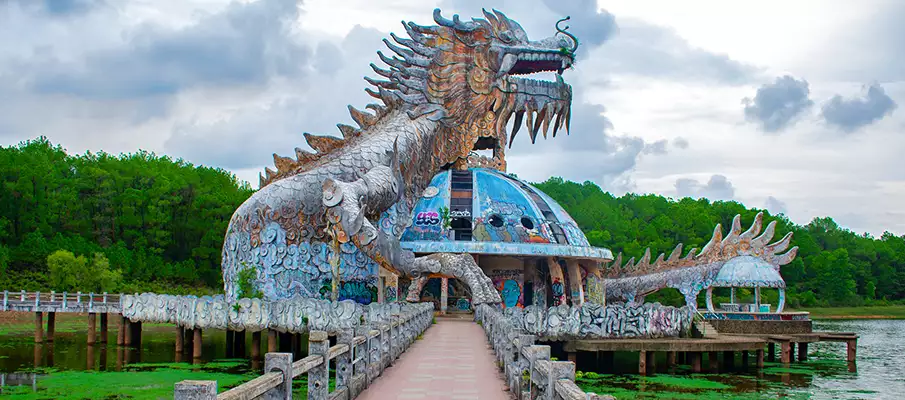
Food and Cuisine in Hue:
-
- Hue is known for its rich and diverse culinary traditions, with a unique blend of Vietnamese, Chinese, and French influences. The city is home to a wide range of dishes and flavors, from rich soups and stews to spicy noodles and savory pancakes.
- One of the most famous dishes in Hue is Bun Bo Hue, a spicy beef noodle soup that is popular throughout Vietnam. The soup features tender slices of beef, pig’s feet, and Vietnamese ham, along with a variety of herbs and spices. Another popular dish is Com Hen, a rice dish that is topped with baby clams, sliced pork, and a variety of herbs and vegetables.
- Hue is also known for its Banh Beo, which are small steamed rice cakes that are topped with dried shrimp, scallions, and crispy pork rind. Another popular dish is Banh Khoai, a savory pancake made with rice flour, turmeric, and mung bean, and stuffed with pork, shrimp, and bean sprouts.
- When it comes to dessert, Hue is known for its Che, a sweet soup made with coconut milk, beans, and fruits. One of the most popular varieties is Che Hue, which features a mix of green and yellow beans, and is often topped with coconut cream and sesame seeds.
- In summary, Hue is a food lover’s paradise, with a rich and diverse culinary heritage that is sure to tantalize the taste buds. Some of the most famous dishes include Bun Bo Hue, Com Hen, Banh Beo, and Banh Khoai, while popular snacks and desserts include Banh Trang Tron, Banh Nam, and Che Hue. Whether you’re a foodie or simply looking to try something new, Hue’s cuisine is not to be missed.
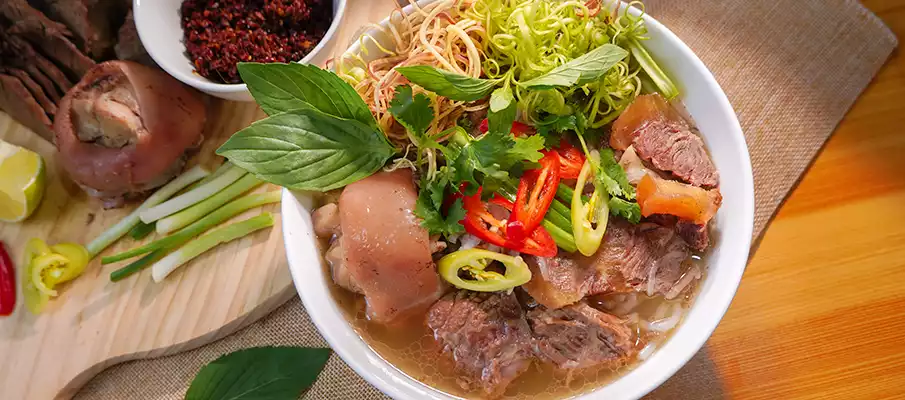
✈️ How to get and travel to Hue?
-
- By Air: The nearest airport to Hue is Phu Bai International Airport, which is located approximately 15 kilometers from the city center. The airport is served by several domestic airlines, including Vietnam Airlines, Vietjet Air, and Bamboo Airways, with direct flights to major cities in Vietnam such as Hanoi or Ho Chi Minh City as well as international destinations such as Bangkok and Seoul.
- By Train: The Reunification Express train runs from Hanoi to Ho Chi Minh City and stops at Hue along the way. The train journey from Hanoi to Hue takes approximately 13 hours, while the journey from Ho Chi Minh City to Hue takes around 22 hours. The train is a great way to see the Vietnamese countryside and is a popular option for budget travelers. There are also sleeper cabins or seats.
- By Bus: There are several bus companies that operate between Hue and other cities in Vietnam, including Hanoi, Ho Chi Minh City, Danang, and Hoi An. The bus journey from Hanoi to Hue takes around 14 hours, while the journey from Ho Chi Minh City to Hue takes approximately 20 hours. Buses are generally the cheapest option for traveling in Vietnam, but can be less comfortable than trains or flights. There are also tourist buses from Da Nang to Hue.
- Book and buy tickets / flights from Hanoi to Hue on Baolau ➜ or 12go.asia ➜

☀️ Weather in Hue + The best time to visit:
-
- Hue has a tropical climate with two distinct seasons: the dry season from March to August, and the rainy season from September to February. The average temperature in Hue ranges from 20°C (68°F) to 35°C (95°F), with high humidity levels throughout the year.
- The best time to visit Hue is during the dry season from March to August, when the weather is sunny and warm with occasional rain showers. The temperatures during this time range from 25°C (77°F) to 35°C (95°F), and the skies are generally clear, making it ideal for outdoor activities and sightseeing.
- You can also read this article: The Best Time to Visit Vietnam.
- The rainy season from September to February can be unpredictable, with heavy rains and occasional flooding. However, the rains can also bring a refreshing change to the hot and humid weather, and the surrounding countryside is lush and green during this time.
- One of the best times to visit Hue is during the annual Hue Festival, which takes place in April and features cultural performances, food and drink stalls, and a variety of traditional activities. This is a great time to experience the rich cultural heritage of Hue and the surrounding areas. ➜ Current weather in Hue.
| Month | Weather | Description |
|---|---|---|
| January | Cool and Dry | In January, Hue experiences cool and dry weather. The average high temperature is around 22°C (72°F), and the low temperature is approximately 17°C (63°F). It’s an ideal time to explore the historic Imperial City, visit the Thien Mu Pagoda, and cruise along the Perfume River. |
| February | Cool and Dry | February continues with cool and dry conditions. The average high temperature remains around 23°C (73°F), and lows are around 18°C (64°F). The comfortable weather is perfect for visiting the royal tombs, enjoying local cuisine, and experiencing the traditional Tet Festival. |
| March | Mild and Dry | March brings mild and dry weather to Hue. The average high temperature is about 25°C (77°F), and lows are around 20°C (68°F). It’s a wonderful time to explore the beautiful Perfume River, take a boat trip to Thien Mu Pagoda, and visit traditional handicraft villages. |
| April | Warm and Dry | In April, Hue experiences warm and dry conditions. The average high temperature is around 28°C (82°F), and lows are approximately 23°C (73°F). It’s an excellent time for outdoor activities like exploring the ancient Ho Quyen Arena and enjoying a bike ride through the countryside. |
| May | Warm and Humid | May continues with warm and humid weather. The average high temperature hovers around 30°C (86°F), and lows are around 24°C (75°F). The humidity increases as the monsoon season approaches. Despite occasional showers, May offers lush landscapes and vibrant local life to explore. |
| June | Hot and Humid | June experiences hot and humid weather. The average high temperature is about 34°C (93°F), and lows are approximately 26°C (79°F). The rainfall increases, but there are also periods of sunshine. June is a quieter month for tourists, allowing for peaceful exploration of historical sites. |
| July | Hot and Humid | July remains hot and humid in Hue. The average high temperature is around 34°C (93°F), and lows are around 26°C (79°F). The rain is more frequent, but it usually comes in short bursts. July is a good time to explore local markets and enjoy refreshing traditional dishes. |
| August | Hot and Humid | August continues with hot and humid weather. The average high temperature hovers around 34°C (93°F), and lows are around 26°C (79°F). The rainfall is more consistent, but it rarely affects outdoor activities. August is ideal for visiting Hue’s beautiful garden houses and enjoying the vibrant Huong River. |
| September | Hot and Humid | September experiences hot and humid weather, with an average high of about 33°C (91°F) and lows of 25°C (77°F). The rain is more frequent, but it usually comes in short, refreshing showers. It’s a good time to explore indoor attractions and engage in local cultural experiences. |
| October | Warm and Dry | October continues with warm and dry conditions. The average high temperature is around 30°C (86°F), and lows are around 24°C (75°F). The weather is suitable for exploring Hue’s iconic attractions like the Tomb of Emperor Tu Duc and taking a leisurely cruise on the Perfume River. |
| November | Cool and Dry | In November, Hue experiences cool and dry weather. The average high temperature remains around 26°C (79°F), and lows are around 21°C (70°F). The comfortable weather makes it an excellent time to explore the serene Thuy Tien Lake and engage in cultural experiences. |
| December | Cool and Dry | December brings cool and dry weather to Hue. The average high temperature hovers around 23°C (73°F), and lows are about 18°C (64°F). It’s a great time to explore the vibrant Dong Ba Market, enjoy Hue’s famous cuisine, and experience the city’s festive holiday spirit. |
🏡 Accommodation in Hue / Where to Stay:
-
- Hue offers a range of accommodation options to suit different budgets and preferences, including budget hostels, mid-range hotels, and luxury resorts. Some popular accommodation options in Hue include:
- Budget hostels and guesthouses: There are several budget-friendly hostels and guesthouses in Hue that offer basic amenities such as shared dorms or private rooms, free Wi-Fi, and common areas for socializing. Some popular options include Hue Happy Homestay, Hue Backpackers Hostel, and Hue Home Hotel.
- Mid-range hotels: There are also several mid-range hotels in Hue that offer comfortable rooms and modern amenities such as air conditioning, Wi-Fi, and flat-screen TVs. Some popular options include Eldora Hotel, Cherish Hotel, and Romance Hotel.
- Luxury resorts: For those looking for a more luxurious experience, there are several high-end resorts in Hue that offer luxurious accommodations, spa services, and fine dining options. Some popular options include Banyan Tree Lang Co, Angsana Lang Co, and Vedana Lagoon Resort & Spa.
- In addition to these options, there are also homestays and boutique hotels available in Hue for travelers seeking a more unique and personalized experience. It’s best to book your accommodation in advance, especially during peak season and major events, to ensure availability and get the best deals.
➜ Accommodation in Hue – Book Here
🔍 Interesting Places + Activities in Hue:
-
- Imperial City: The Imperial City of Hue is a UNESCO World Heritage Site and serves as a historical treasure trove. It was once the imperial capital of Vietnam and continues to captivate visitors with its grandeur. Within its fortified walls lie elaborate gates, temples, and palaces, all of which offer a glimpse into the rich history of the Nguyen Dynasty. Explore this sprawling complex to discover the legacy of Vietnamese royalty.
- Hue Museum of Royal Antiquities: This museum is renowned for its extensive collection of artifacts, art, and historical items related to the imperial history of Vietnam, particularly the Nguyen Dynasty, which ruled the country from the early 19th century until the early 20th century.
- Thien Mu Pagoda: Thien Mu Pagoda is a sacred Buddhist temple perched along the serene banks of the Perfume River. Visitors can ascend its towering pagoda for breathtaking panoramic views of the surrounding landscape. The temple grounds are adorned with a multitude of shrines and statues, making it a peaceful and culturally rich destination.
- Tomb of Tu Duc: The Tomb of Tu Duc serves as the final resting place of Emperor Tu Duc, a prominent figure of the Nguyen Dynasty. Wander through the meticulously landscaped gardens and admire the intricate architecture that graces this imperial resting place. Gain insights into the life and enduring legacy of this emperor as you explore the site.
- Mausoleum of Emperor Khai Dinh: The Mausoleum of Emperor Khai Dinh, also known as the Khai Dinh Tomb, is a significant historical and architectural site located in Hue, Vietnam. It serves as the final resting place of Emperor Khai Dinh, the 12th emperor of the Nguyen Dynasty, who ruled Vietnam from 1916 to 1925. The construction of the mausoleum began during Khai Dinh’s reign and was completed in 1931, several years after his death.
- Mausoleum of Emperor Minh Mang: It is one of the many royal tombs and mausoleums found in the vicinity of Hue, a city known for its rich imperial history. The mausoleum was built to honor Emperor Minh Mang, the second ruler of the Nguyen Dynasty, who reigned from 1820 to 1841.
- An Dinh Palace: An Dinh Palace is a historical and architectural site that served as the residence of Bao Dai, the last emperor of the Nguyen Dynasty and the final ruler of Vietnam, from 1916 until 1945. It is an important part of Vietnam’s history, as it was the home of the country’s last monarch during a period of significant political and social change.
- Nguyen Dinh Chieu Walking Street: The Nguyen Dinh Chieu Walking Street is a popular pedestrian street and cultural space located in Hue, Vietnam. Named after Nguyen Dinh Chieu, a renowned 19th-century Vietnamese poet and scholar, this pedestrian street was established to provide a vibrant and attractive area for both locals and tourists to enjoy.
- Hue Night Walking Street: The Hue Night Walking Street, also known as „Pho Dem Hue“ in Vietnamese, is a popular and vibrant pedestrian street located in the city of Hue, Vietnam. This lively street comes to life in the evening and is dedicated to creating a unique and enjoyable atmosphere for both locals and tourists alike.
- Perfume River: The Perfume River winds its way through the heart of Hue, offering a picturesque and tranquil waterway. To fully appreciate the beauty of the city and its lush countryside, take a boat tour along this meandering river. It’s a perfect way to immerse yourself in the natural splendor of Hue.
- Hue Citadel: The Hue Citadel is yet another UNESCO World Heritage Site, emblematic of Vietnam’s rich cultural heritage. Within its walls, visitors can explore the imposing ramparts, gatehouses, and elegant temples that together compose this historical fortress. It’s a significant location for those seeking to delve deeper into Vietnam’s past.
- Thuy Tien lake Abandoned Water Park: The Thuy Tien Lake Abandoned Water Park is a haunting and surreal attraction located on the outskirts of Hue. Originally conceived as a luxurious water park with a colossal dragon-shaped centerpiece, it was never completed due to financial issues and has been abandoned since 2011. Its decaying structures and eerie atmosphere have garnered the attention of urban explorers and curious travelers.
- Dong Ba Market: Dong Ba Market is a vibrant local market where visitors can immerse themselves in the lively atmosphere of Vietnamese commerce. It’s an excellent place to shop for souvenirs, sample an array of local street food, and engage with friendly market vendors. The market is a hub of local culture and an opportunity to experience daily life in Hue.
- Hue Street Food Tour: Hue is renowned for its delectable cuisine, and a street food tour is an ideal way to savor the flavors of the region. Indulge in culinary specialties such as banh khoai (pan-fried rice pancakes), bun bo Hue (spicy beef noodle soup), and banh beo (steamed rice cakes). This culinary journey allows you to appreciate the authentic taste of Hue.
- Thuan An Beach: Thuan An Beach is a stunning coastal retreat located just a short distance from Hue. The sandy shores invite visitors to relax in the sun, swim in the crystal-clear waters, and enjoy a feast of fresh seafood at the many beachside restaurants. It’s the perfect place to unwind and soak in the beauty of the coast.
📍 Hue in Central Vietnam – Google Map:
❓ Frequently Asked Questions + Travel Tips about Hue:
1. How to book and buy train/bus tickets or flights to Hue?
2. What is the best time to visit Hue?
-
- The best time to visit Hue is from March to August when the weather is warm and dry. However, keep in mind that Hue can be crowded during peak tourist season, so consider traveling during the shoulder seasons of September to February to avoid the crowds.
3. Is it safe to travel to Hue?
-
- Yes, Hue is generally a safe destination for travelers. However, as with any destination, it’s important to take normal safety precautions, such as being aware of your surroundings and avoiding unlit areas at night.
4. What should I wear when visiting religious sites in Hue?
-
- When visiting religious sites in Hue, it’s important to dress modestly and cover your shoulders and knees. You should also remove your shoes before entering any temples or pagodas.
5. Can I rent a motorbike in Hue?
-
- Yes, you can rent a motorbike in Hue. However, be aware that traffic in Vietnam can be chaotic and driving a motorbike can be dangerous if you’re not experienced. Make sure to wear a helmet and drive defensively.
6. What are some popular day trips from Hue?
-
- Some popular day trips from Hue include visiting the Demilitarized Zone (DMZ) that marked the border between North and South Vietnam during the Vietnam War, exploring the nearby ancient city of Hoi An, or visiting the Bach Ma National Park for hiking and nature activities.
7. What is the food like in Hue?
-
- Hue is known for its flavorful and spicy cuisine, which includes dishes such as bun bo Hue (spicy beef noodle soup), banh khoai (pan-fried rice pancakes), and nem lui (grilled pork skewers). Seafood is also popular in Hue due to its proximity to the coast.
8. What is the nightlife like in Hue?
-
- Hue is not known for its nightlife scene, but there are a few bars and clubs in the city center that stay open late. Alternatively, you can enjoy a sunset boat ride along the Perfume River or attend a traditional performance at the Hue Royal Theatre.
9. Is it necessary to hire a guide when visiting the Imperial City of Hue?
-
- While it’s not necessary to hire a guide when visiting the Imperial City of Hue, having a guide can greatly enhance your experience. A knowledgeable guide can provide historical and cultural context, as well as point out important details that you may have otherwise missed. However, if you prefer to explore on your own, there are guidebooks and audio guides available.
10. What souvenirs should I buy in Hue?
-
- Hue is known for its traditional handicrafts, such as silk scarves, conical hats, and lacquerware. You can also find souvenirs related to Hue’s imperial history, such as miniature replicas of the Citadel or royal costumes. Food and beverage items, such as Hue’s famous chili sauce or green tea, are also popular souvenirs. Be sure to shop at reputable stores to avoid buying counterfeit or low-quality items.
11. What is the historical significance of Hue in Vietnam?
-
- Hue is historically significant as the former imperial capital of Vietnam, serving as the political, cultural, and religious center for nearly 143 years. It was the seat of the Nguyen Dynasty, the last ruling dynasty of Vietnam, from 1802 to 1945.
12. How did Hue become the imperial capital of Vietnam?
-
- Hue became the imperial capital when Emperor Gia Long, the founder of the Nguyen Dynasty, established it as the capital in 1802. He chose the location due to its favorable geographic position and as a way to consolidate his rule.
13. What are some of the most famous historical sites in Hue?
-
- Hue is home to numerous historical sites, including the Imperial City, the Royal Tombs, Thien Mu Pagoda, and several temples and shrines. The Imperial City, a UNESCO World Heritage site, is a particularly significant attraction.
14. Why is Hue’s history associated with the Vietnam War?
-
- Hue gained notoriety during the Vietnam War when it was the site of intense fighting during the Tet Offensive in 1968. The Battle of Hue was one of the longest and bloodiest battles of the war.
15. How to travel solo in Vietnam?
-
- Discover the wonders of solo travel in Vietnam as you explore ancient temples, cruise through scenic landscapes or karst sceneries, hike various national parks and ethnic villages and connect with the warm-hearted locals, creating a personalized journey of cultural immersion and breathtaking experiences.
16. What are the most popular and beautiful islands in Vietnam?
-
- Vietnam has a lot of beautiful islands also accessible for tourists. One of the most popular is Phu Quoc in southern Vietnam, but you should carefully read this article about 10 Best Islands in Vietnam.
BOOK A TOUR / ACTIVITY in Hue ➜
| Interesting Facts about Hue: | Description |
|---|---|
| 1. Imperial City | Hue is home to the Imperial City, a UNESCO World Heritage Site and the former capital of Vietnam from 1802 to 1945. The Imperial City showcases the grandeur and architectural brilliance of the Nguyen Dynasty, with its palaces, temples, royal tombs, and the Forbidden Purple City, offering a glimpse into Vietnam’s imperial history. |
| 2. Perfume River | The Perfume River flows through Hue, offering scenic views and tranquil boat rides. The river derives its name from the fragrant flowers that fall into the water during autumn, creating a delightful aroma. Along the riverbanks, you can find historical landmarks, such as the Thien Mu Pagoda and the Hue Citadel, surrounded by lush landscapes and peaceful ambiance. |
| 3. Thien Mu Pagoda | Thien Mu Pagoda is an iconic symbol of Hue, perched on a hill overlooking the Perfume River. Built in the 17th century, the pagoda is the tallest religious building in Vietnam and holds significant cultural and historical importance. Its seven-tiered tower, known as the Phuoc Duyen Tower, is a symbol of Hue and offers panoramic views of the surrounding landscapes. |
| 4. Royal Tombs | Hue is renowned for its elaborate royal tombs, where the emperors of the Nguyen Dynasty were laid to rest. These tombs, scattered along the Perfume River and surrounding hills, showcase stunning architecture, intricate details, and beautiful garden landscapes. Each tomb reflects the personality and taste of the respective emperor, creating a unique blend of art, culture, and nature. |
| 5. Hue Cuisine | Hue is known for its unique and delicious cuisine, influenced by royal traditions. The city’s culinary offerings include iconic dishes like bun bo Hue (spicy beef noodle soup), com hen (clam rice), and banh khoai (Hue-style pancake). These specialties showcase the distinct flavors and presentation that make Hue cuisine a must-try experience for food lovers. |
| 6. Thanh Toan Bridge | Thanh Toan Bridge, also known as the Japanese Covered Bridge, is a historic landmark in Hue. Built in the 18th century, the bridge is an architectural marvel and a symbol of the historical connection between Vietnam and Japan. It features a unique design with a covered roof, serving as a shelter for pedestrians while providing a picturesque view of the surrounding rural landscape. |
| 7. Hue Festival | Hue hosts the biennial Hue Festival, a vibrant celebration of arts, culture, and traditions. The festival showcases a wide range of performances, exhibitions, and activities, including traditional music, dance, fashion shows, and street parades. It attracts artists and spectators from around the world, offering a unique opportunity to immerse yourself in the rich cultural heritage of Hue. |
| 8. Garden Houses | Hue is famous for its traditional garden houses, which are architectural gems. These houses combine elements of Vietnamese, Chinese, and French influences, featuring exquisite woodwork, intricate carvings, and beautiful gardens. The garden houses reflect the harmony between humans and nature, serving as tranquil retreats and showcasing the aesthetics of Hue’s traditional architecture. |
| 9. Citadel Walls | The Citadel Walls surround the Imperial City, providing a glimpse into the city’s historical defenses. Built in the early 19th century, the walls stretch for over 10 kilometers and feature watchtowers, gates, and moats. The Citadel Walls are a testament to Hue’s rich history and serve as a reminder of the city’s past grandeur and strategic importance. |
| 10. Hue Traditional Music | Hue is renowned for its traditional music, known as Nha Nhac. This court music originated from the Nguyen Dynasty and was performed during royal ceremonies and important events. The music is characterized by its delicate melodies, elegant dance movements, and intricate instrumental ensemble. Visitors can enjoy mesmerizing performances of this ancient art form at various cultural shows and performances in Hue. |
Book your Accommodation in Hue ➜
Thanh Hoa Province|Krabi to Koh Jum|Battambang to Bangkok|Rayong to Koh Samet|Weather in Karon|Weather in Patong|Weather in Railay
